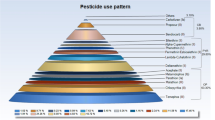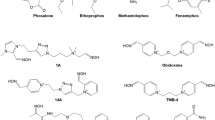Abstract.
Organophosphorothionates (OPT) are one of the most widely used insecticides in the world, both in agriculture and in indoor environment. Therefore, a large part of the population may be exposed to this class of pesticides, either professionally or due to their presence in food and water as residues. OPTs acute toxic effects, mediated by acetylcholinesterase (AChE) inhibition, are relatively selective to insects. However, most of the thousands of deaths annually reported to be associated to pesticide exposure are due to OPT severe poisoning, resulting in hyperexcitability of the nervous system. In addition, long-term neurological and neurobehavioral effects have been described, associated to chronic exposure to OPT low levels.
Metabolism is one of the main factors determining OPT adverse effects. OPTs need to be bioactivated by a cytochrome P450 (CYP)-mediated desulfuration to phosphate triesters or oxons, which are the actual powerful inhibitors of brain and serum AChE. The main detoxification pathways are oxon hydrolysis catalyzed by plasma oxonases (PON1), `sequestration' or hydrolysis by carboxylesterases, CYP-catalyzed dearylation/dealkylation. Variation activity of the enzymes involved in OPT metabolism could be expected to contribute to differences in susceptibility to OPT toxic effects, either due to genetic polymorphism or environmental influence, altering the bioactivation/detoxication ratio.
The reactions involved in OPT metabolism in humans are described in the paper, with consequences for OPT-induced toxicity. In addition, identification of biomarkers of susceptibility and interactions among different OPTs and with other xenobiotics are briefly discussed, as factors influencing risk assessment of cumulative effects due to OPT exsposure.
Similar content being viewed by others
Abbreviations
- AChE:
-
acetylcholinesterase
- ADRs:
-
adverse drug reactions
- AZIN:
-
azinphos-methyl
- CE:
-
carboxylesterases
- Cli:
-
intrinsic clearance
- CPF:
-
chlorpyrifos
- CYP:
-
cytochrome P450
- DIA:
-
diazinon
- DIM:
-
dimethoate
- FEN:
-
fenthion
- FMO:
-
flavin-containing mono-oxigenase
- IMI:
-
imipramine
- IsoMAL:
-
isomalathion
- MAL:
-
malathion
- OP:
-
organophosphorus compounds
- OPT:
-
organophosphorothionates
- PAR:
-
parathion
- PON1:
-
oxonases
Author information
Authors and Affiliations
Corresponding author
Rights and permissions
About this article
Cite this article
Buratti, F.M., Leoni, C. & Testai, E. The Human Metabolism of Organophosphorothionate Pesticides: Consequences for Toxicological Risk Assessment. J. Verbr. Lebensm. 2, 37–44 (2007). https://doi.org/10.1007/s00003-006-0109-z
Published:
Issue Date:
DOI: https://doi.org/10.1007/s00003-006-0109-z




